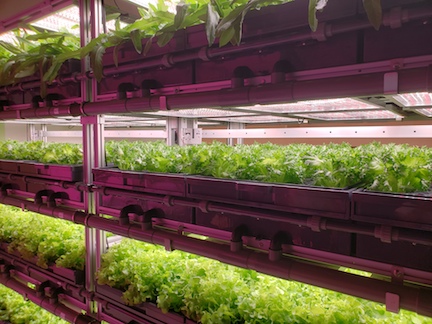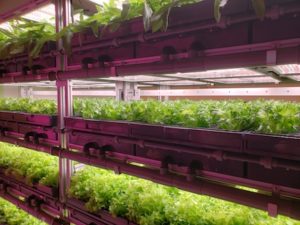
Crops Suitable for Vertical Farming
Vertical farming refers to the production of plants grown in stacked horizontal or vertical layers, or other three-dimensional configurations. Most commercial vertical farms produce crops inside buildings, relying on light-emitting diodes (LEDs) as the sole light source. Although there are some vertical farms inside greenhouses, the variability in light intensity caused by shading from crops and structures above create challenges to producing a uniform crop.
There continues to be increasing interest in vertical farming, especially by entrepreneurs and governments of countries that rely on the importation of food crops. However, because the costs to build and operate a vertical farm are high, only certain types of crops are potentially profitable. This article describes some of the crop characteristics that lend themselves to indoor production.
Short production cycle. Considering the high costs of producing crops indoors, crops that can be produced in weeks — not months — lend themselves to indoor farming. The longer it takes to produce a crop, the greater the electricity cost for lighting and operation of the heating, ventilation and air conditioning systems, as well as the greater fixed costs (rent, equipment depreciation, etc.) that must be allocated to that crop.
High harvestable yield. This refers to the portion of the crop that can be harvested and sold. For crops like lettuce, almost the entire plant can be sold and thus, has a very high harvestable yield. In contrast, for a crop like tomato, one can only sell the fruits. The energy used to generate and maintain leaves and stems is essentially “lost” because there is no market for those portions of the plant.
Short stature. Plants that have a compact growing habit are more suitable for vertical farming because the distance between growing layers can be relatively short. Space is used less efficiently with taller crops. Unless the distance between the lights and the plants can be adjusted (which is often not practical), more lighting capacity is needed to reach the plants when they are young. As plants grow closer to the light, the light intensity at the crop canopy increases, but also becomes more variable.
Year-round demand. Profitability usually necessitates continuous operation and thus, there must be sufficient year-round market demand for the crop(s) grown. Producing the same crop year-round is much easier horticulturally, and it allows growing systems to be engineered and optimized specifically for that crop. One can imagine rotating crops seasonally, when the market price for each crop is highest, but this makes automation of the growing and harvesting processes difficult at best.
Limited labor. Vertical farmers often report that labor is one of their largest costs. Thus, crops that can be “sown and grown” with little labor lend themselves to vertical farming. Automation decreases labor inputs, but it usually requires significant up-front costs to design, purchase and install.
Perishable. One of the virtues of indoor farming is the ability to produce crops close to where they are sold, such as large cities. The shelf life and/or quality of perishable crops can be increased when the period between harvest and reaching the market is short. A short harvest to market time can also reduce shrinkage compared with crops transported long distances.
High value. Because of the greater costs of producing crops indoors, they need to command a relatively high price. We can produce any food crop indoors, but is the price obtained sufficiently high to be profitable?
Value added. It is possible to produce a higher-quality crop indoors compared to conventional or greenhouse farming. In addition, crops grown indoors are typically more reliable and uniform than other production methods. Additional value-added attributes that are possible include more nutritious; “better” texture, flavor, and/or color; and a longer shelf life. Can these higher-quality products obtain a higher price than those produced conventionally?



 Video Library
Video Library 




















